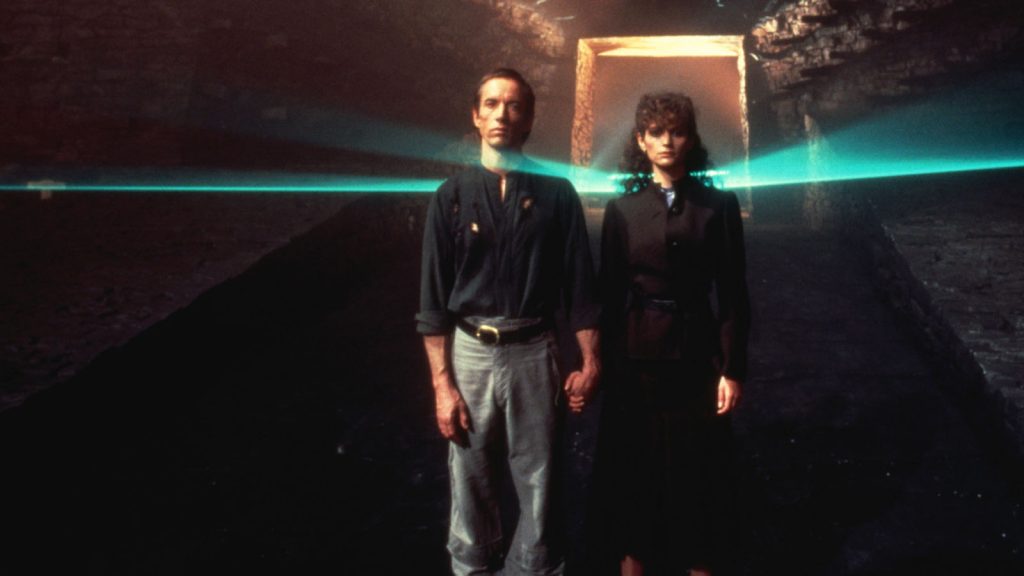
The tale of an amateur entomologist (Eiji Okada) lured by seemingly amiable rural folk into a sand pit from which he is unable to escape, Woman in the Dunes would seem to generate its particular strain of terror from our primal fear of sequestration and austerity. Yet what gives this masterpiece of Japanese modernism special resonance is its disregard for the sanctity of the individual. Mesmerizing imagery conflates fingerprints with the ever-shifting lines formed in sand by wind, one of several ways in which the film suggests the plasticity of identity. It isn’t enough to be confined in a hostile environment, to be forced into Sisyphean labor, to be deposited into an undesired domestic partnership with a widow (Kyoko Kishida), to be subjected to acts of savagery and humiliation—the film’s protagonist must, above all, bear witness to the erosion of his free will.
Woman in the Dunes is the second and most widely celebrated of four feature collaborations between director Hiroshi Teshigahara, writer Kobo Abe, and composer Toru Takemitsu, each one an insightful, exquisitely sinister portrait of self-alienation. While a faithful adaptation of Abe’s novel of the same name, Woman in the Dunes is anything but a literary movie: Abe’s screenplay favors action, behavior, and implication over words, while Teshigahara’s gift for arresting visual design—in concert with Takemitsu’s disorienting, atonal bursts of musical noise—transforms what is essentially a chamber piece into something spectacularly immersive. The sleeping widow’s naked flesh slowly becoming crusted with gleaming grains; the weary squeak of the winch that draws crates of sand up from the bottom of the pit, while denying like passage to the pleading protagonist; the pounding drums and firelit masks of the villagers as they try to goad the entomologist and the widow into public intercourse: every scene in Woman in the Dunes fuses beauty and horror, deviance and eros.
A village movie, a parable of gynophobia, a refutation of postwar Japan’s civil institutions: Woman in the Dunes—released in 1964, the same year as Onibaba and a peak period for Japanese horror—lends itself to any number of readings. At its core is a chilling story of experiment and adaptation, a thematic pairing that turns proto-Cronenbergian when revisited in the film’s boldly transgressive successor, The Face of Another. Our insistence on survival proves our will to be endlessly malleable, Woman in the Dunes suggests, until we finally come to cherish the very circumstances that imprison us. 🩸

is a freelance critic and playwright.
Consider the Dies Irae. Eight dire notes to remind you that you are going to die.
BY TOM PHELAN | July 26, 2024
The opening images of Kaneto Shindo’s exquisite, dread-drenched, medieval Japan–set Onibaba (1964) are overlaid with telegraphic fragments of text...
BY JOSÉ TEODORO | November 15, 2024
A swarm of samurai emerge from a bamboo grove in firefly patterns, arriving at the threshold of a humble hut. The scene is nearly silent, false tranquility preceding a torrent of savagery.
BY JOSÉ TEODORO | November 8, 2025

This pre-Code offering packs a lot of story into its typically brisk running time, with several plot threads weaving together a (not always successful) tapestry of spooky and criminal doings.
READ MORE >
BY ANN OLSSON | Month 00, 2021

In what could be the fastest-resulting rape revenge movie, a drunken lout brutally forces himself on Ida, the young woman who doesn't return his affections, during a party over Labor Day.
READ MORE >
BY LAURA KERN | Month 00, 2021

Beast is a lot of movies in one package - fractured fairy tale, belated-coming-of-age story, psychological drama, regional horror film - but above all it's a calling card for its leading lady, Jessie Buckley.
READ MORE >
BY LAURA KERN | Month 00, 2021